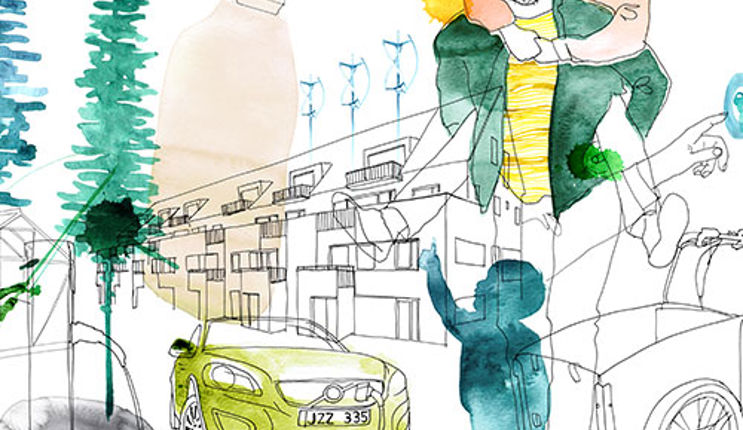
In Umeå, Energy planning is a collective effort
When it comes to energy solutions at Tomtebo Strand, the local energy company Umeå Energi is leading the way. The collaboration group includes business developers Magnus Stenvall and Frida Strindlund.
Can you tell us more about working with the Tomtebo Strand model?
M: Our approach is in the challenge. Everyone wants to find sustainability in their operations, but while most look at specific solutions in parts of the system, we in this project focus on the larger system. Collaboration gives a broader perspective. We must find solutions that contribute to increased sustainability for the entire society. Traditionally, it's often "we do something really cool on our own without any thought of it being interconnected," but that’s really not the case here. We truly want Tomtebo Strand to be a role model for sustainable urban development.
What smart energy solutions will Tomtebo Strand receive?
F: We’re not there yet. This project spans over 10-15 years, and exactly what the solutions will look like then, we don't know now. What we are working on now is how we create an infrastructure today with flexibility for the future.
M: The general description is to share energy and create more renewable production while building flexible infrastructure solutions. We must think sustainability in all dimensions, and that is a challenge.

The Tomtebo Strand model, in short, means that with vision-driven planning, co-creation, and learning as cornerstones, and with a long-term and holistic approach, we create sustainability on many different levels. The idea is that the methodology can be used in Umeå's future work to develop the city.
Is the Tomtebo Strand model unique in Sweden?
M: Yes, as far as we know, this is quite unique, that the municipality, municipal companies, and private property actors collaborate in this early phase and to this extent. I don’t think it’s done anywhere else. It's definitely the first time we work like this.
F: The engagement makes one plus one equal three. We lead in energy issues, where there are big challenges and great potential. We try to see beyond system boundaries, where we can jack the systems into each other. These are incredibly important questions.
What are the advantages for Umeå Energi in working with this model?
F: This is a way for us to work customer insight-driven with property owners and construction actors, who are often our "usual" customers. We learn a lot about their conditions and needs and can simultaneously explore tomorrow's energy landscape in a completely different way than in traditional projects. Moreover, we are a local energy company, and working like this with sister companies and our local community is incredibly important. In traditional construction projects, it can often happen that the actors' different focuses lead to suboptimization of the whole.
M: A concrete lesson for all of us in the collaboration project has been that we all have gained an even greater understanding that the building norms can be quite limiting - they set boundaries around each building. In this project, we have seen the district as the system, not the individual buildings.
M: Another insight we’ve gained when sitting together has been that a decision that may seem to concern the energy system also affects the mobility solutions. We see so clearly how a decision in the area has consequences for other parts. We become more aware that things like how we sort waste can affect CO2 levels in our heat production. This shared view is not something we previously lived with in our respective businesses, and it truly challenges the traditional business models.
What does this form of collaboration bring to you as professionals?
F: In my role, a lot is about understanding tomorrow's needs, so for me, this is an incredible tool for building that understanding. It's often easy to get into a technology focus, but with the rapid development, it's difficult to plan long-term. As technology evolves, needs change, and we need to meet them with flexibility.
Do you think there's a reason Umeå is the first to adopt this model?
F: You could say that the Tomtebo Strand model has evolved from the "Network for Sustainable Building," where various actors in the construction chain, authorities, and competing companies have collaborated and developed competencies in sustainability issues for many years. In 2017, they said, "Can't we do even more?" And when planning an entirely new urban district, they saw the opportunity to take collaboration to the next level. In the project, we have together developed the Tomtebo Strand model. So, one could say it's the result of a long history of successful collaborations in Umeå.
You've mentioned wanting to build an Internet of Energy at Tomtebo Strand. What does that mean?
M: The Internet of Energy is about combining traditional energy systems, which involve a lot of wiring and piping, with digital solutions for today's virtual world. Combining these worlds is a way to optimize all properties at Tomtebo Strand and enhance sustainability for the properties, the district, and the entire city.
WHAT IS THE INTERNET OF ENERGY (IOE)?
Internet of Energy (loE) isa technological term that refers to the upgrading and automating of electricity infrastructures for energy producers and manufacturers. This allows energy production to move forward more efficiently and cleanly with the least amount of waste. The term isderived from the increasingly prominent market for Internet of Things (loT) technology, which has helped develop the distributed energy systems that makeup the loE.
The article was published in issue 3 2022, Urban Planning.
Text by Jessica Larsson Svanlund, freelance writer.